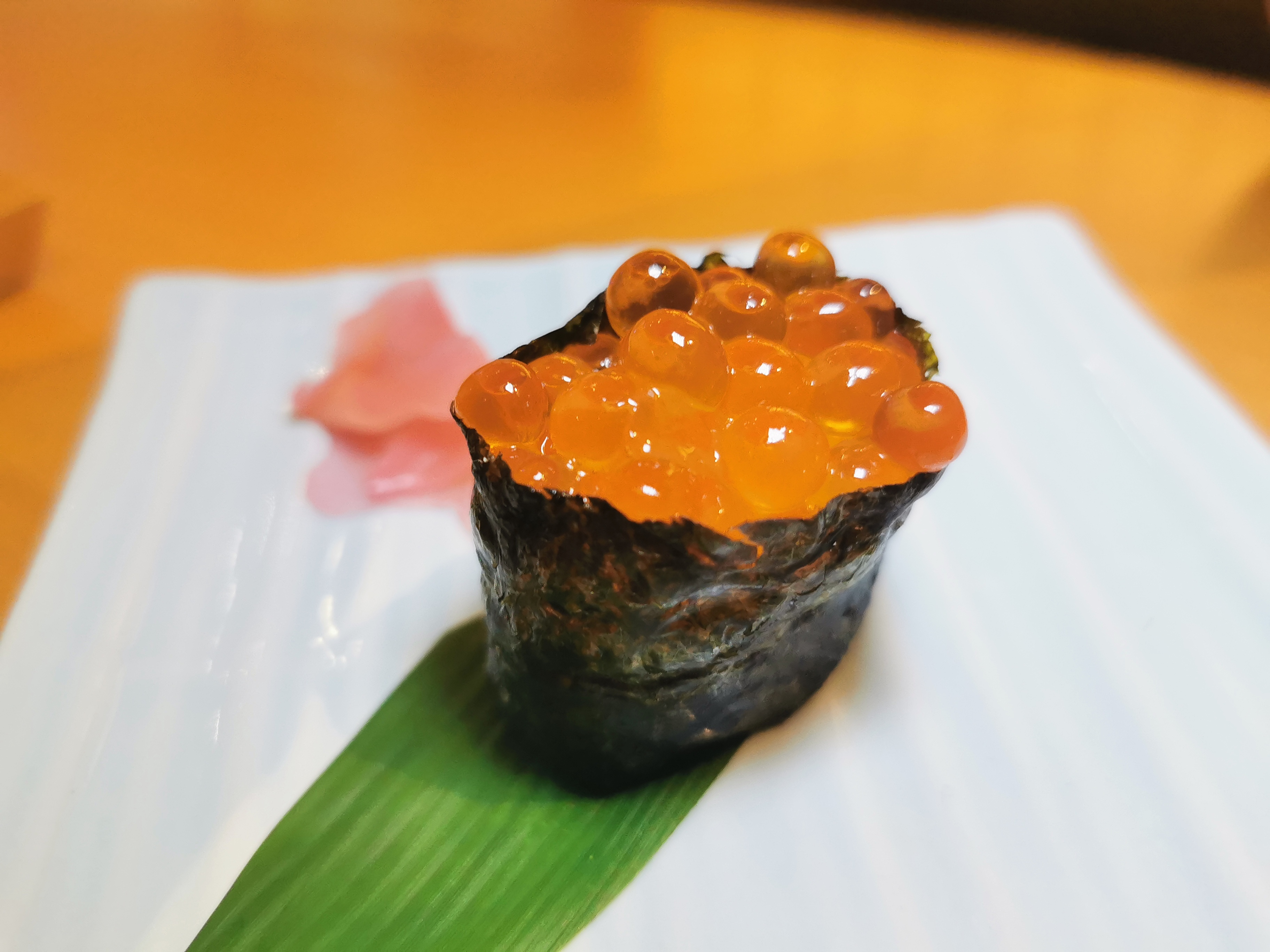Ikura De: The Ultimate Guide To This Beloved Japanese Delicacy
Hey there, foodies and sushi lovers! If you're into Japanese cuisine, chances are you've come across ikura de—those vibrant orange orbs of goodness that pack a punch of umami flavor. But what exactly is ikura, and why does it hold such a special place in the culinary world? Let’s dive in and explore the wonders of this delightful dish, from its origins to how it’s enjoyed today. You’re in for a treat, trust me.
Ikura, in its simplest form, refers to salmon roe that has been salted and preserved. It’s not just any fish egg; it’s a delicacy that’s celebrated for its rich, briny taste and satisfying texture. Whether you’re a sushi connoisseur or just starting to explore Japanese cuisine, ikura is one of those ingredients that can elevate any dish. But there’s so much more to it than meets the eye—or the taste buds, for that matter.
In this article, we’ll take a deep dive into everything you need to know about ikura, from its cultural significance to its nutritional benefits. If you’ve ever wondered how to enjoy ikura to its fullest or where to find the best quality roe, you’re in the right place. So, buckle up and let’s get started!
What Exactly is Ikura De?
Ikura de is essentially the Japanese term for salmon roe, which is the eggs of the salmon fish. These tiny, jewel-like spheres are a staple in Japanese cuisine and are often used as a topping for sushi, rice bowls, and other dishes. The word "ikura" itself comes from the Russian word "ikra," which means "fish roe." Over time, the term was adopted into the Japanese language, and the rest, as they say, is history.
One of the reasons ikura is so beloved is its unique texture and flavor profile. When you bite into a piece of ikura, you’ll experience an explosion of flavor as the egg bursts in your mouth. It’s salty, briny, and slightly sweet, making it a perfect complement to the delicate flavors of sushi rice and other Japanese dishes.
The Origins of Ikura
Believe it or not, ikura didn’t originate in Japan. Its roots can be traced back to Russia, where salmon roe was traditionally consumed as a delicacy. However, it wasn’t until the 20th century that ikura made its way to Japan, where it quickly became a staple in sushi restaurants and households alike.
Japan’s love affair with ikura can be attributed to its emphasis on umami, the fifth taste that’s often described as savory and satisfying. Ikura’s briny, salty flavor perfectly aligns with this concept, making it a natural fit for Japanese cuisine. Over the years, chefs and home cooks alike have found countless ways to incorporate ikura into their dishes, from simple rice bowls to elaborate sushi creations.
How is Ikura Made?
Now that we’ve covered the basics, let’s talk about how ikura is made. The process is relatively simple but requires precision to ensure the roe retains its quality and flavor. Here’s a quick breakdown:
- First, fresh salmon roe is carefully removed from the fish.
- Next, the eggs are washed and cleaned to remove any impurities.
- After that, the roe is lightly salted and marinated to enhance its flavor and preserve it.
- Finally, the ikura is packaged and ready to be enjoyed!
It’s worth noting that high-quality ikura is made using fresh, sustainably sourced salmon roe. This ensures that the final product is not only delicious but also environmentally friendly.
The Cultural Significance of Ikura
In Japan, ikura holds a special place in the culinary tradition. It’s often served during special occasions, such as New Year’s celebrations, where it symbolizes good fortune and prosperity. The vibrant orange color of the roe is also associated with happiness and joy, making it a popular choice for festive meals.
Beyond its cultural significance, ikura is also valued for its nutritional benefits. It’s packed with omega-3 fatty acids, vitamins, and minerals, making it not just a delicious treat but also a healthy one. In fact, many health enthusiasts swear by ikura as a superfood that supports heart health and brain function.
Popular Dishes Featuring Ikura
Ikura’s versatility makes it a favorite among chefs and home cooks alike. Here are some of the most popular dishes that feature this delightful ingredient:
- Ikura Don: A simple yet satisfying dish consisting of sushi rice topped with a generous helping of ikura.
- Ikura Gunkan Maki: A type of sushi roll where ikura is placed on top of a small bed of rice wrapped in nori seaweed.
- Ikura Pasta: A fusion dish where ikura is mixed with pasta and a creamy sauce for a delicious twist on traditional Italian cuisine.
These dishes are just the tip of the iceberg when it comes to the many ways ikura can be enjoyed. Whether you’re a sushi purist or a fan of fusion cuisine, there’s something for everyone when it comes to ikura-based dishes.
Where to Find the Best Ikura
If you’re looking to try ikura for yourself, there are a few things to keep in mind. First and foremost, quality matters. Look for ikura that’s made from fresh, sustainably sourced salmon roe. You can find high-quality ikura at specialty food stores, Japanese markets, and even online retailers.
When shopping for ikura, pay attention to its appearance and texture. Good quality ikura should have a vibrant orange color and a firm, plump texture. Avoid roe that looks dull or has a mushy consistency, as this may indicate that it’s not fresh.
Tips for Storing Ikura
Once you’ve purchased your ikura, it’s important to store it properly to maintain its quality. Here are a few tips:
- Keep ikura refrigerated at all times. It should be stored at a temperature between 32°F and 40°F (0°C to 4°C).
- Use ikura within a few days of purchase for the best flavor and texture.
- If you need to store it for longer, consider freezing it. However, keep in mind that freezing may slightly alter its texture.
By following these simple tips, you can ensure that your ikura stays fresh and delicious for as long as possible.
Health Benefits of Ikura
As we mentioned earlier, ikura is not just a tasty treat—it’s also packed with nutritional benefits. Here are some of the key health benefits of consuming ikura:
- Rich in Omega-3 Fatty Acids: Ikura is an excellent source of omega-3 fatty acids, which are known to support heart health and reduce inflammation.
- High in Vitamins and Minerals: It’s also a good source of vitamins D and B12, as well as minerals like phosphorus and selenium.
- Boosts Brain Function: The omega-3 fatty acids in ikura have been shown to support cognitive function and may even help improve memory.
So, the next time you’re enjoying a dish featuring ikura, remember that you’re not only indulging in a delicious treat but also doing something good for your body.
Common Misconceptions About Ikura
Despite its popularity, there are a few misconceptions about ikura that we’d like to clear up:
Myth 1: Ikura is only for sushi lovers. While ikura is commonly associated with sushi, it can be enjoyed in a variety of dishes, from pasta to salads. Don’t let its association with sushi deter you from trying it in other forms!
Myth 2: Ikura is difficult to prepare. In reality, ikura is quite easy to use. Simply open the package and add it to your dish of choice. No complicated preparation required!
Fun Facts About Ikura
Here are a few fun facts about ikura that you might not know:
- Ikura is one of the most expensive types of fish roe, second only to caviar.
- The size and color of the roe can vary depending on the species of salmon it comes from.
- Ikura is often used in Japanese cooking competitions as a test of a chef’s skill and creativity.
Who knew there was so much to learn about these little orange spheres?!
How to Enjoy Ikura at Home
If you’re ready to try ikura for yourself, here are a few simple recipes to get you started:
Ikura Don Recipe
Ingredients:
- 1 cup sushi rice
- 1/2 cup water
- 2 tablespoons rice vinegar
- 1 tablespoon sugar
- 1 teaspoon salt
- 1/2 cup ikura
Instructions:
- Cook the sushi rice according to package instructions.
- In a small saucepan, combine the rice vinegar, sugar, and salt. Heat over low heat until the sugar dissolves.
- Once the rice is cooked, transfer it to a large bowl and mix in the vinegar mixture.
- Divide the rice into bowls and top with the ikura. Serve immediately and enjoy!
Conclusion
So there you have it, folks—everything you need to know about ikura de. From its origins to its cultural significance and nutritional benefits, ikura is truly a remarkable ingredient that deserves a place in every food lover’s heart. Whether you’re a sushi enthusiast or just looking to try something new, ikura is sure to impress with its vibrant flavor and satisfying texture.
Now that you’ve got the scoop on ikura, why not give it a try? Head to your local Japanese market or specialty food store and pick up a pack of high-quality ikura. Trust me, your taste buds will thank you. And if you’ve got any questions or tips of your own, feel free to leave a comment below. Happy eating, and see you in the next article!
Table of Contents
- What Exactly is Ikura De?
- The Origins of Ikura
- How is Ikura Made?
- The Cultural Significance of Ikura
- Popular Dishes Featuring Ikura
- Where to Find the Best Ikura
- Health Benefits of Ikura
- Common Misconceptions About Ikura
- How to Enjoy Ikura at Home
- Conclusion

IKURA Oh!SUSHI

Ikura Sushi Traditional Rice Dish From Japan

Ikura Norecipes Elevating Everyday Meals